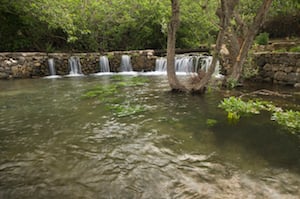Caesarea Philippi
Caesarea Philippi is the site of an ancient spring in northern Israel where Jesus took his disciples to reveal his identity as the Messiah, the Son of God.
Today, the location is known as Banyas or Banias (see it on a map here), which is an evolution of the ancient name, Paneas. That ancient name reflects the patron of this beautiful spring—the god of nature, Pan, because the spring that flows from the rock in Banias is a significant tributary of the Jordan River, the most important source of water in the region where the Israelites lived. Today, the Banias is preserved as an Israel National Park.
Herod the Great—the governor who met with the magi seeking the infant Jesus—built a temple to Pan on the site of the springs. When he died, the area he historically ruled over was split among his sons, who governed these regions for the Roman conquerors. Herod’s son, Philip, inherited the northern region around this site, and built his capital city around the springs of Banias, naming it Caesarea Philippi to honor Caesar.
In Jesus’ time, water flowed from a spring within the cave pictured above. Subsequent earthquakes shifted the source of the water further down the hill, but a lot of water still flows from this original cave—20 cubic meters per second.
The dominant rock cliff and abundant, fresh, cold water make it a place of primordial elements. The pagan power centered here translated to political power as well—the location served as something of a royal resort and administration center. These associations make it an interesting place to contemplate authority.
When Jesus asked his followers, “Who do you say that I am?” Simon identified Jesus as the Messiah, the Son of God. Jesus replied by changing his name: “I tell you, you are Peter, and on this rock I will build my church, and the gates of Hades will not prevail against it.” Why did Jesus choose this location to bestow authority upon Peter (a gift still carried by the Church)?
Peter, of course, means “rock,” so Jesus might have well been using this location to create a bold image for how this rock is to serve as a foundation for the Church. It is to be certainly solid and strong, just as this rock cliff, and at the same time, it is to also give life, like the spring that flows from here. If Jesus likens the foundations of the Church to this place, it means that the Church should be a rock and a river, a stronghold and a mission, both powerful and life-giving. It is to be a fortress that bears fruit and feeds people wherever it flows.
In 29 AD, John the Baptist was killed, and in response, Jesus moved away from teaching around Capernaum and went north to Caesarea Philippi with his disciples. This place would have been a refreshing change of scenery and a welcome retreat in that moment of loss and confusion.
The Gospel describes Jesus as going into the “wilderness outside Caesarea Philippi,” but this wilderness is anything but desert. Jesus went into the desert for 40 days to prepare himself for his public ministry in solitude. In stark contrast, Banias, on the foothills of the beautiful Mt. Hermon, is lush, teeming with trees and wildlife. Here is where Jesus tells Peter that he will be the new rock, the new foundation of a fruitful, abundant new community known as the Church. What did it feel like for Jesus and his followers to be here; to go into this clear, fresh, cold water; to pray here with streams bubbling around them, surrounded by life?
In 29 AD, John the Baptist was killed, and in response, Jesus moved away from teaching around Capernaum and went north to Caesarea Philippi with his disciples. This place would have been a refreshing change of scenery and a welcome retreat in that moment of loss and confusion.
The death of John the Baptist reminded Jesus what was at stake with his claim of being the Messiah—the powerful do not accommodate challenges to their authority. If John was killed for proclaiming the truth and “making straight the way of the Lord,” what might Jesus have expected would happen to him when he claimed to be God’s Son? This connection explains the second part of the Gospel reading associated with this site: “From that time on, Jesus began to show his disciples that he must go to Jerusalem and undergo great suffering at the hands of the elders and chief priests and scribes, and be killed, and on the third day be raised.” Jesus’ followers are destined for the paradisical gardens of Banias, but they first must pass through the great suffering of the cross to reach it.
Take in the sights and sounds of this place, and pray for a few moments with this short video:
Gospel Passages Associated with this Site
- Mt 16:13-23
- Mk 8:27-33





